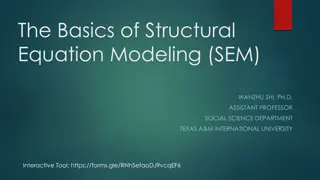
Mastering Economic Growth Models_ A Complete Guide for Sem 5 Students
Master key economic growth models with this comprehensive guide for Sem 5 students, covering essential theories, applications, and exam tips for success.
Download Presentation

Please find below an Image/Link to download the presentation.
The content on the website is provided AS IS for your information and personal use only. It may not be sold, licensed, or shared on other websites without obtaining consent from the author. If you encounter any issues during the download, it is possible that the publisher has removed the file from their server.
You are allowed to download the files provided on this website for personal or commercial use, subject to the condition that they are used lawfully. All files are the property of their respective owners.
The content on the website is provided AS IS for your information and personal use only. It may not be sold, licensed, or shared on other websites without obtaining consent from the author.
E N D
Presentation Transcript
Mastering Economic Growth Models: A Complete Guide for Sem 5 Students Economic growth models are crucial for understanding how economies expand and evolve over time. For Sem 5 students studying economic growth, mastering
these models is essential to grasp how factors like capital, labor, technology, and policy influence growth patterns. This guide will help you navigate the key models in economic growth, providing a strong foundation for exams and future studies in economics. Key Points to Master Economic Growth Models 1. Understanding the Solow Growth Model The Solow Growth Model is fundamental to studying long-term economic growth. It focuses on the roles of capital accumulation, labor growth, and technological progress. Be sure to understand how steady-state equilibrium is reached and the concept of diminishing returns to capital. 2. Endogenous Growth Theory Unlike the Solow model, which assumes exogenous technological change, endogenous growth theory focuses on how economic factors like innovation, knowledge, and human capital contribute to sustained growth. Pay attention to key models like Romer s model and the AK model that explain how policies can influence growth rates in the long run. 3. Harrod-Domar Model This model connects savings, investment, and economic growth. It is particularly useful for analyzing developing economies and understanding the role of investment in growth. Be sure to understand the concept of the
growth rate and how it is determined by the investment rate and capital-output ratio. 4. Comparing Growth Models A key aspect of studying economic growth is being able to compare different models. Focus on their assumptions, long-run predictions, and policy implications. This includes analyzing how different models address the effects of capital accumulation, technological progress, and labor growth. 5. Role of Technological Progress Technological progress is one of the most significant drivers of economic growth. Understanding how technology drives productivity, shifts production functions, and affects long-run growth is essential. Pay special attention to how the Solow model incorporates technological progress and the implications of technological spillovers in endogenous growth models. 6. Growth Policies and Their Implications Economic growth models often inform government policies aimed at stimulating or managing growth. Familiarize yourself with how growth models suggest policies related to investment in human capital, infrastructure, and innovation. Understanding the role of fiscal and monetary policy in boosting or constraining growth is also crucial.
7. Real-World Applications and Limitations While the models are theoretically sound, their real-world application can be limited by factors like institutional constraints, global shocks, or political challenges. Be prepared to discuss these limitations and how actual economic performance may deviate from model predictions. 8. Exam Preparation Tips Focus on understanding the core assumptions and mechanisms of each model. Practice solving problems related to each growth model to strengthen your application skills. Use past year papers to familiarize yourself with exam patterns and the type of questions asked. Additional Key Points for Mastering Economic Growth Models 9. The Role of Institutions in Economic Growth Institutions such as property rights, legal systems, and political stability play a significant role in fostering or hindering economic growth. The importance of institutional frameworks is well-explained in models of endogenous growth and by scholars like Douglass North. Understanding
how strong institutions lead to sustainable growth by promoting investment and innovation is critical. 10. The Impact of Human Capital Human capital, which refers to the education, skills, and health of a workforce, is a central element in many growth models. Models like the Romer model emphasize how knowledge accumulation and education contribute to increasing productivity and innovation. Be sure to explore how human capital interacts with physical capital in shaping economic growth. 11. The Lewis Model of Structural Change For students in developing economies, the Lewis model of structural change is important. This model explains how economies move from an agrarian to an industrialized economy, highlighting the role of labor transfer from low-productivity sectors to high-productivity sectors. Understand how this model explains development processes in countries like India and China. 12. Demographic Factors in Growth Models Demographic factors, such as population growth and aging, have significant implications for long-term economic growth. The Solow model includes population growth as a key variable, and understanding its effect on savings rates and capital accumulation is essential. Additionally, you
should be aware of how demographic transitions can affect economic growth in the long run. Useful link: Understanding The Role of Game Theory in Economic Decision Making






















